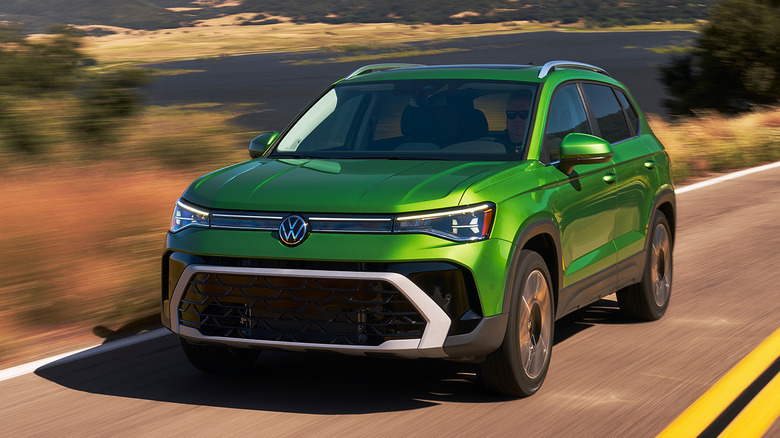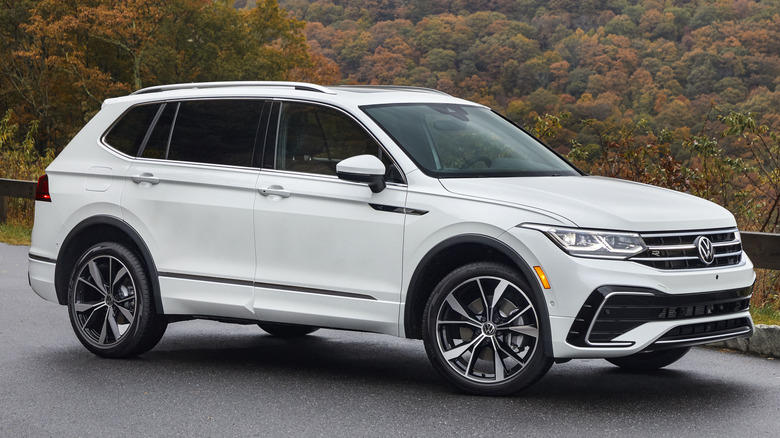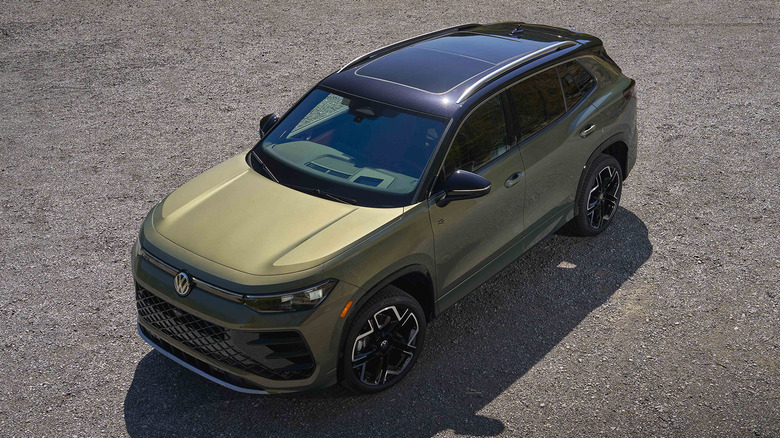What's The Difference Between The Volkswagen Tiguan And Taos?
With the explosion of the crossover SUV market over the last decade, there are many cases where automakers are offering different crossover models that seem to overlap each other. Volkswagen is one of them, with its current lineup offering both the Tiguan and Taos models in the compact crossover space.
In the official hierarchy, the Taos represents the entry-level SUV in Volkswagen's American lineup, with a starting price (before destination) that comes in just under $25,0000. The Tiguan is the next step up, being both longer in size and more expensive than the Taos, with a starting price of about $4,000 higher at $28,880.
Beyond that, though, aspects and differences begin to get a little blurry between each of VW's crossover models. On both paper and in the real world, the cheaper Taos outperforms the aging Tiguan in some areas — and not just in the expected categories of price and fuel economy.
Size isn't everything
Both the Tiguan and Taos come standard in front-wheel drive, with VW's 4Motion AWD system available as an option on both. Earlier years of the 4Motion Taos got a seven-speed DSG transmission, but for 2025, that was changed to the same eight-speed automatic used in the front-drive Taos as well as the Tiguan.
Being a the larger, heavier vehicle, the Tiguan gets a bigger 2.0-liter turbocharged four-cylinder engine, while the Taos gets VW's smaller 1.5-liter turbo four-cylinder. The differences in output aren't as big as you might think: The Tiguan makes 184 horsepower, just seven more than the Taos' 177 horsepower. The Tiguan does, however, have a more significant torque advantage — with 221 pound-feet over the Taos' 184 pound-feet of torque.
When it comes to acceleration, though, it's the Taos that gets the edge, typically outperforming the Tiguan in both 0-60 mph time and the quarter-mile. Unfortunately, VW doesn't offer an engine upgrade for the current Tiguan, so even the pricey, fully-loaded trims make do with the same 184 horsepower engine. Ultimately, neither crossover is particularly known for performance or being fun to drive over other Volkswagen models.
Still, most crossover buyers are more concerned with interior and cargo capacity than they are with drag racing. Again, kind of a mixed bag between the two: The longer Tiguan can carry more cargo, and can be had with a third row seat — albeit a very small one. For first and second row occupants, the Tiguan's space advantage is minor, with the Taos actually doing a better job optimizing its interior space to its overall size. The Taos' smaller size and smaller engine also give it a fuel economy edge, though not a massive one. A FWD Taos has a combined EPA rating of 31 MPG to the FWD Tiguan's 27 MPG rating.
Change is coming
At the moment, the biggest drawback of the Tiguan is simply its age. The current Tiguan has been on sale (with a few updates) since the 2018 model year, while the Taos arrived for the 2022 model year. However, this will change in 2025.
Volkswagen has already announced a completely redesigned 2025 Tiguan for the American market, scheduled to start hitting dealers this summer. Along with new styling and the expected tech updates, the new Tiguan will get a much-needed horsepower bump for all trims. Even better, a new range-topping SEL R-Line model is on the way, making more horsepower than the GTI hot hatch, and packs standard 4Motion AWD.
Nobody wants to be outdone by their little brother, and in many areas, that's been the case with the current Tiguan and Taos. If you are in the market for a new Volkswagen crossover, our easy advice is to wait a few more months for the next-gen Tiguan to see how it re-establishes itself in VW's growing SUV lineup.


